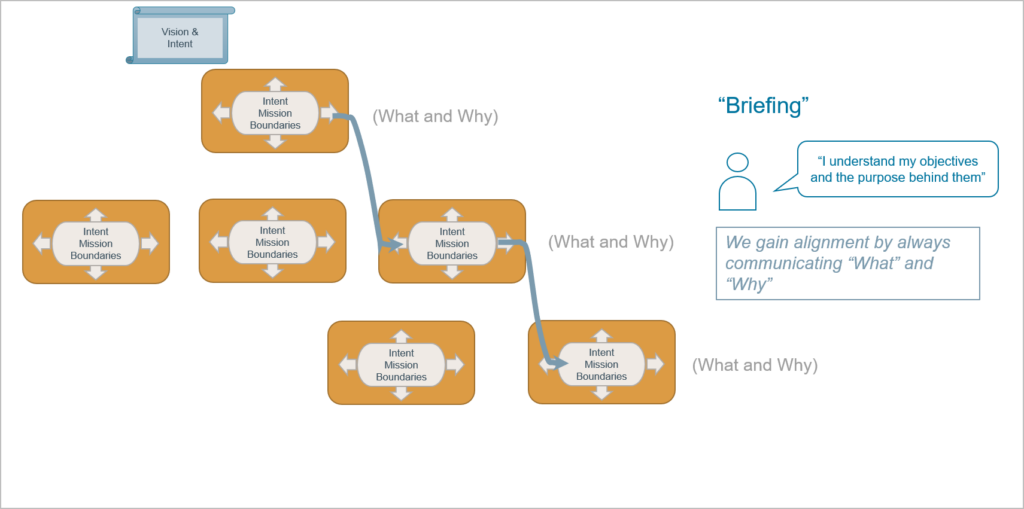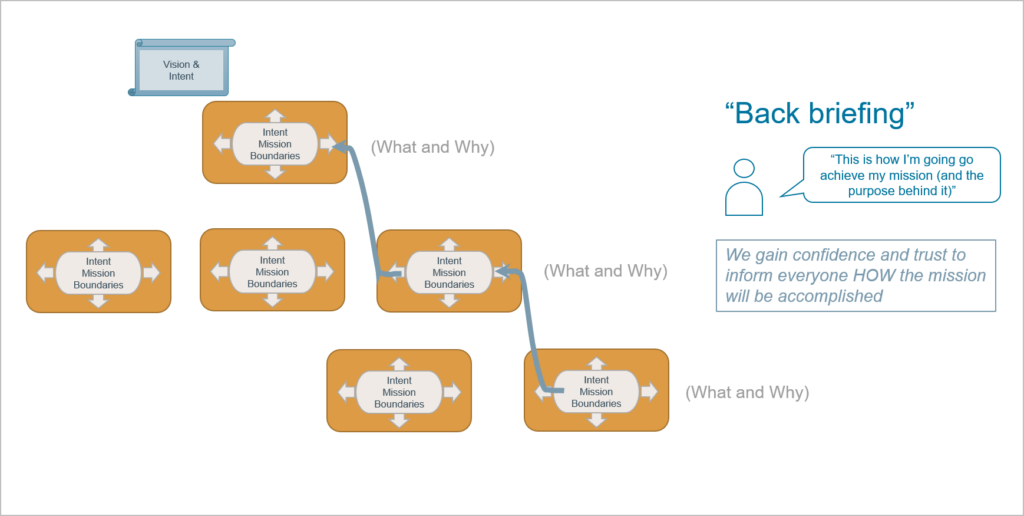5. Facilitating alignment


Why it matters
Agile organizations balance high alignment with high autonomy. When organizations attempt to be Agile at scale, they need a way to ensure that high alignment is maintained otherwise incoherence would result.
People cannot be compelled to align. Instead, leaders facilitate alignment by ensuring that there is a two-way process of communicating intent throughout the organization, confirming through feedback that people understand it and that their responses will align with it.

How it works
Agile strategy refers to the two-way communication process as ‘briefing’ and ‘back briefing ’. The process used to facilitate alignment supports trust, creates a common shared understanding, and creates a virtuous circle by providing an opportunity to build confidence and to listen to ‘views from the floor’.
Briefing and back briefing include the consideration of interdependencies, so it’s best conducted collectively to ensure that there are no gaps and no overlaps throughout the organization. The whole organization is aligned by repeating the process in a cascade with all critical functional and cross-functional teams.
Briefing
Strategic intent and any essential direction is communicated down and throughout the organization in a cascade. Each critical management team (whether functional or cross-functional) is guided by the intention of the level above in the context of the overall organizational purpose. Each team then develops its specification from this briefing and continues the cascade to the lowest level where independent decisions can be made.

The briefing should always be a collective process so that the discussion required to establish a common operating picture, clarity about intent and freedom to operate takes place with peers. Anyone with an important contribution to the mission should be involved.
In this way, the strategic intent provides a thread of clarity from the top to the bottom of the organization. And conducting the process in groups will also create peer-to-peer alignment as it is much clearer where mutual support is required.
Back briefing
Back briefing supports the cascade of the intent. Each level translates the intent for themselves (see Practice 2), defines what they need to do and how they propose to achieve the intent.
Having translated the intent and decided how to achieve what is required, teams report back, in what is called a “back brief” to confirm their understanding of the intent and that their actions are coherent and adequately resourced.

Using a common approach enables the process to work effectively as information is presented in a familiar structure, which helps leaders to assimilate information quickly and respond to it. A back briefing process has two components:
- The team or leader describes their understanding of the intent and specify WHAT they intend to do in response (i.e. HOW they will deliver the intent), what freedoms they need and who they need to seek advice from.
- The leader being briefed has an opportunity to ask questions for clarification and confirm alignment to their intent.
More detailed action planning and the process of seeking advice and de-conflicting effort with others should be done by those who are to take the actions.
Critical leadership behaviors
Briefing and back briefing aim to build trust and confidence that people are aligned and able to act autonomously. This will be reinforced by appropriate leader behavior. Leaders should not ‘over-direct’ or add too much detail in their briefing, nor should they apply any more constraints to subordinates than the minimum necessary. When listening to back briefing the key questions for leaders are:
- Have they understood the intent?
- Was I sufficiently clear about what is really important?
- Given what I have heard, is it achievable?
- Do they have enough freedom to act and decide?
- Are they ready to use it?
The key listening skill is to receive a back briefing with an open mind thinking “How can I support you to do it your way” NOT “I wouldn’t have done it that way”.